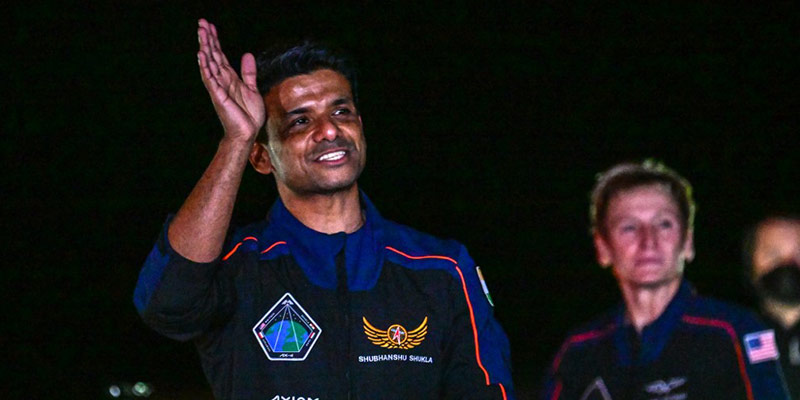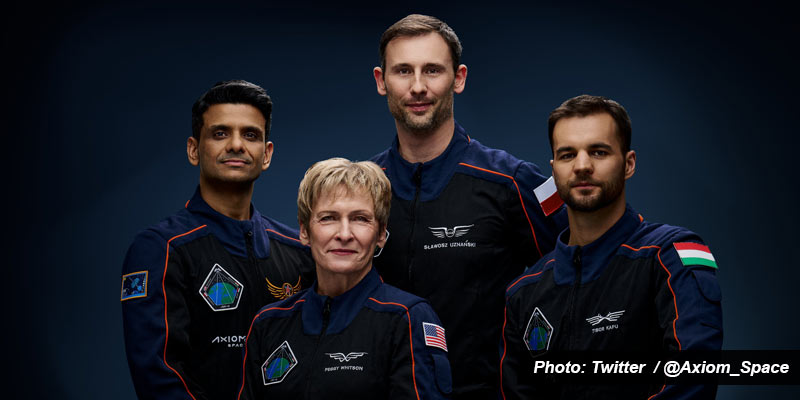- India
- Jun 25
India’s Shubhanshu Shukla scripts history with launch of Axiom-4 mission
• Axiom-4 mission with a crew including Indian astronaut Shubhanshu Shukla lifted off from NASA’s Kennedy Space Centre in Florida onboard SpaceX Falcon 9 rocket to the International Space Station on June 25.
• The Ax-4 crew members are Commander Peggy Whitson of the US, Pilot Shubhanshu Shukla of India, Mission Specialist Sławosz Uznański-Wiśniewski of Poland, and Mission Specialist Tibor Kapu of Hungary.
• The Axiom 4 (Ax-4) crew will be welcomed aboard the orbiting space laboratory on June 26.
• Once docked, the private astronauts plan to spend up to 14 days aboard the orbiting laboratory.
• Shukla becomes the first astronaut to travel to the International Space Station, a journey that comes 41 years after Rakesh Sharma’s eight days in orbit as part of the then Soviet Union’s Salyut-7 space station in 1984.
Who is Shubhanshu Shukla?
• Shubhanshu Shukla was born on October 10, 1985, in Lucknow.
• After graduating from CMS Aliganj Campus I, Shukla was commissioned as a fighter pilot in the Indian Air Force in 2006.
• As a combat leader and seasoned test pilot, he boasts an impressive 2,000 hours of flight experience across various aircraft, including the Su-30 MKI, MiG-21, MiG-29, Jaguar, Hawk, Dornier, and An-32.
• Group Captain Shukla was shortlisted under ISRO’s Human Spaceflight Program and is among the top contenders for the Gaganyaan mission.
• His journey aboard the Axiom-4 mission is expected to provide critical hands-on experience in spaceflight operations, launch protocols, microgravity adaptation, and emergency preparedness — all essential for India’s crewed space ambitions.
• What sets Shukla’s mission apart is its strategic importance. Unlike the symbolic undertones of India’s first human spaceflight, this time the focus is on operational readiness and global integration.
• Shukla’s participation underscores India’s growing engagement with public-private international partnerships in space and its resolve to emerge as a serious contender in human space exploration.
Axiom-4 mission
• The flight is operated by Axiom Space in partnership with SpaceX and NASA.
• The Axiom-4 mission (Ax-4) crew includes Commander Peggy Whitson of the United States, Mission Pilot Shubhanshu Shukla of India, Mission Specialist Sławosz Uznański-Wiśniewski of the European Space Agency (ESA)/Poland, and Mission Specialist Tibor Kapu of Hungary.
• Ax-4 represents a pivotal moment in the growth of commercial human spaceflight.
• For the first time in history, astronauts from India, Poland, and Hungary will fly together to the International Space Station as part of a government-sponsored mission — with each nation returning to human spaceflight after more than four decades.
• While Ax-4 marks these countries’ second human spaceflight mission in history, it will be the first time all three nations will execute a mission on board the International Space Station.
• During their planned 14-day mission, the Ax-4 crew will live and work aboard the orbiting laboratory conducting around 60 different research activities representing 31 countries. The studies will contribute to human research, Earth observation, and life, biological, and material sciences, showcasing each country’s space research initiatives.
• This mission will enable opportunities for industrial advancements and technological development to drive discovery off the planet.
• The Ax-4 mission stands as a beacon of opportunity for India, Poland, and Hungary, each poised to leverage this mission to advance their national space programs.
• The first private astronaut mission to the station, Axiom Mission 1, lifted off in April 2022 for a 17-day mission aboard the orbiting laboratory.
• Axiom Mission 2 was launched in May 2023 with four private astronauts who spent eight days in orbit.
• Axiom Mission 3 was launched in January 2024 and the crew spent 18 days docked to the space station.
Manorama Yearbook app is now available on Google Play Store and iOS App Store



